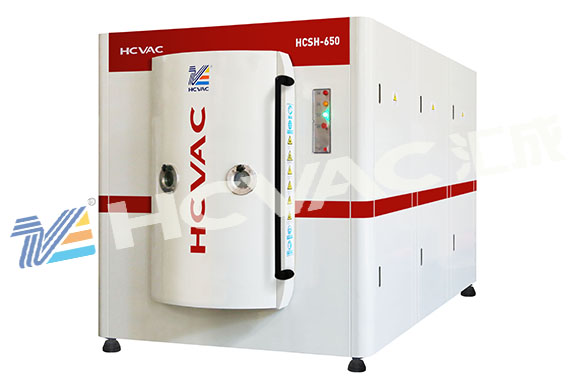How to choose the coating materials for decorative vacuum coating machine, and what are the application ranges? Many customers have such doubts and confusion in their hearts, and do not know how to choose materials. This is the focus of the discussion below. In decorative vacuum coating, depending on perfect coating technology, the coating with strong abrasion resistance, good adhesion and high brightness can be obtained.

1. Functions and requirements of decorative vacuum coating machine on coating
Decorative vacuum plating coatings are generally divided into two types: primer and top coating. In order to meet the different technical requirements of the product, the primer and top coat can be applied, or the color coating and protective coating can be applied on the top coat. The main functions of these coatings are:
Improve the adhesion of the film. Using the same coating method, the adhesion of the film can be improved by applying the primer on the plastic substrate and then vacuum coating.
Reduce the surface roughness of plated parts and improve the brightness. Generally, the surface of plated parts has micro unevenness, and the flatness of coating with different thickness can fill the defects on the surface of plated parts and make the surface of plated parts reach mirror flatness.
It can protect the metal film. Generally, the vacuum coating is only 100nm, and the abrasion resistance and anti discoloration ability of the coating are poor. After the surface coating is applied, the coating does not directly contact with the outside world, which can protect the coating.
Requirements for primer in vacuum plating:
① It has good contact performance and high binding force for the plated part and the coating layer, small difference in thermal expansion coefficient, no reaction, and good leveling performance.
② It has good vacuum performance. After curing, the primer has less outgassing, less thermal stress and good heat resistance.
③ The film forming performance is good, and the coating has good density, coverage, solvent resistance and light resistance.
④ It has good compatibility with the surface coating. Because the coating layer is extremely thin and porous, it is required that the solvent and diluent of the primer and top coat have good compatibility.
⑤ The coating performance is good. Good leveling performance, proper viscosity and short curing time.
Requirements for vacuum plating surface coating:
① Good contact performance with the coating layer;
② It shall have a certain compatibility with the primer;
③ Excellent film forming and coating properties; Have appropriate mechanical strength;
④ Good moisture resistance, solvent resistance and corrosion resistance. Strong anti-aging performance.
Due to the special needs of products, superhard coating or color coating can be further applied on the surface coating.
2. Common coatings
The commonly used coatings for vacuum plating include UV curable coatings, acrylic ester coatings, alkyd resin coatings, epoxy resin coatings, polyurethane coatings, etc.
(1) UV curable coatings:
UV curable coating is a kind of coating cured by chemical reaction under the irradiation of UV light with wavelength of 250~450nm. Features:
decorative vacuum coating machine The coating coating does not need to be heated directly, as long as it cannot be solidified with ultraviolet light, it can save energy, and the curing speed is fast. It is suitable for automatic assembly line in minutes and seconds; The coating has excellent performance, large coating adhesion, high covering power, low surface roughness, good vacuum performance and less solvent content, which is conducive to environmental protection.
This UV curable coating mainly includes photosensitizer (photopolymerization initiator), photosensitive resin (prepolymer) and active diluent, as well as necessary stabilizer, leveling agent and pigment.
The photosensitive resin contains double bonds and can be cured to form a film by self radical polymerization. The appropriate photosensitizer can shorten the curing reaction time and improve the performance and stability of the film. Benzoin ethers are commonly used as photosensitizers. In recent years, thioxanthone compounds developed in combination with N, N, - dimethylethanolamine can obtain extremely hard films.
Photosensitive resin contains double bonds that can be photopolymerized. It is the main film-forming material in the coating, which determines the performance of the film. There are two types of commonly used photosensitive resins: vinyl type and acryloyl type.
Active diluents are monomers or oligomers containing unsaturated double bonds, which can not only reduce the viscosity of coatings, but also participate in the light curing reaction. They can form films with photosensitive resins. The commonly used active diluents also include vinyl and acrylic types.
Usually, the addition of leveling agent can improve the surface tension of the coating and promote the rapid leveling of the film. The commonly used leveling agents include cellulose and sorbitol surfactants.
(2) Acrylate paint:
Acrylate coating is generally made of methacrylate and acrylate copolymer resin.
Features of acrylate coating: It has excellent color and luster, good light and color retention performance, moisture resistance, mold resistance, solubility resistance, acid and alkali resistance, and heat resistance, and can be used below 180 ℃.
(3) Alkyd resin coating:
Alkyd resin is a kind of resin formed by esterification of polyols, polybasic acids and fatty acids. The coatings with alkyd resin as the main film-forming material are called alkyd resin coatings.
The characteristics of alkyd resin coating: it has excellent luster, good light and color retention performance, and the film layer is flexible and firm, resistant to friction, but poor salt spray, mold and moisture resistance.



